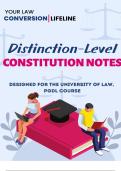Summary
Summary Constitutional Law Notes (DISTINCTION) for University of Law Post Graduate Diploma in Law (PGdL) course
- Course
- Institution
Distinction level Constitutional Law (English Legal Systems) notes (overall grade, 84) Crafted by a recent graduate who received a distinction in the very same course, these notes are tailored to your PGDL program, ensuring they cover the crucial Constitutional Law concepts you need to master. ...
[Show more]



